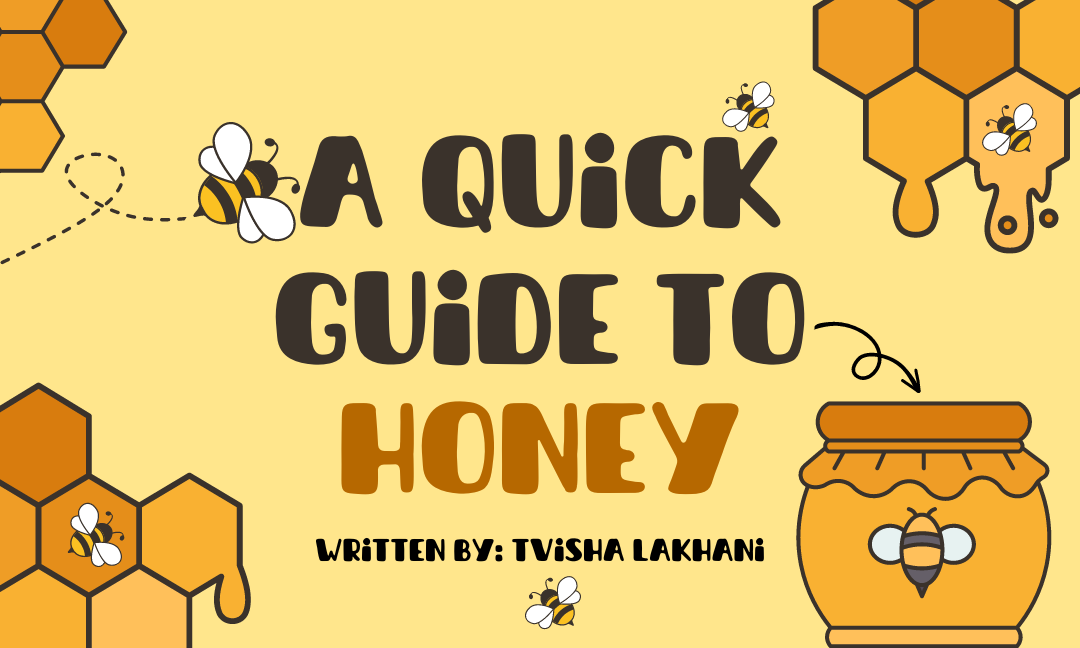Written by: Tvisha Lakhani
Edited by: Koneenika Datta
Designed by: Ayesha
Published by: Maryam Khan
 If you’ve ever been to your local farmer’s market, you’ve probably seen a stall with rows of glistening jars filled with amber-toned honey. A viscous, semi-transparent liquid found around the globe, honey is a natural sweetener that’s been used for thousands of years.
If you’ve ever been to your local farmer’s market, you’ve probably seen a stall with rows of glistening jars filled with amber-toned honey. A viscous, semi-transparent liquid found around the globe, honey is a natural sweetener that’s been used for thousands of years.
The earliest record of honey being used by humans is from a cave painting from 8,000 BCE found in Spain, portraying a human attempting to get some honey from a beehive. Since then, the usage of honey has been seen in many ancient civilizations.
 Today, most of the honey you buy is either raw or pasteurized. Pasteurized honey is honey that has been processed and heated before packaging. This honey is often smoother than raw honey. Raw honey is packaged straight from the hive. One place to find raw honey is at your local farmer’s market. This honey usually has small traces of pollen, yeast, and wax, along with certain nutrients and minerals that pasteurized honey usually does not have. Due to this, consuming raw honey is believed to have many health benefits.
Today, most of the honey you buy is either raw or pasteurized. Pasteurized honey is honey that has been processed and heated before packaging. This honey is often smoother than raw honey. Raw honey is packaged straight from the hive. One place to find raw honey is at your local farmer’s market. This honey usually has small traces of pollen, yeast, and wax, along with certain nutrients and minerals that pasteurized honey usually does not have. Due to this, consuming raw honey is believed to have many health benefits.
Some examples of these health benefits may include improving heart health, reducing the severity of seasonal pollen allergies, improving cholesterol levels, and more. Honey has antibacterial and anti-inflammatory effects, making it useful for treating burns. Honey is often used as a cough remedy because it can lessen inflammation in the throat and its thick texture can coat irritated receptors, reducing the urge to cough. It should be noted, however, that giving honey to children below the age of one isn’t recommended due to the risk of botulism.
Honey comes from honeybees. They collect nectar from nearby flowers and turn it into honey, which is stored in their hive to be used as food. Many varieties of honey can be found based on what kind of flowers the honey bees get nectar from. Some examples may include wildflower, blueberry, buckwheat, and summer blossom.
All varieties of honey offer a slightly different flavour, colour and thickness. Some varieties even have more health benefits than others. When cooking with honey, switching around the type of honey used can often completely change the dish, so always try experimenting with different kinds of honey to turn a dish into something unique.
To conclude, if you aren’t allergic to it, honey is a great sweetener to start using in your everyday life if you haven’t already!
Works Cited
Angelini, D. (2019, October 4). The Fascinating History of Honey. Bugs in Our Backyard. https://bugsinourbackyard.org/the-fascinating-history-of-honey/
Berry, J., & Marengo, K. (2023, April 5). How are Raw Honey and Regular Honey Different? Medical News Today. https://www.medicalnewstoday.com/articles/324966
Incorvaia, D. (2021, August 15). Honey’s Eternal Shelf Life, Explained. Discover Magazine. https://www.discovermagazine.com/planet-earth/honeys-eternal-shelf-life-explained
Lugmayer, K. A. (2017). Honey Glasses Food [Photograph]. Pixabay. https://pixabay.com/photos/honey-glasses-food-sweeteners-2328350/
Millar, S. (2020, April 14). Where Does Honey Come From? The Scottish Bee Company. https://www.scottishbeecompany.co.uk/blogs/news/where-does-honey-come-from
Ontario Beekeepers’ Association. (n.d.). Neat Facts about Bees. All About Ontario Honey. https://www.ontariohoney.ca/kids-zone/bee-facts
Rosenbloom, C., & Pinto-Garcia, P. (2023, May 17). Does Honey Really Work to Soothe a Cough? GoodRx Health. https://www.goodrx.com/conditions/cough/does-honey-help-cough
Shoemaker, S., & Chin, K. (2023, May 15). Everything to know about the Health Benefits of Honey. Healthline. https://www.healthline.com/nutrition/benefits-of-honey
Ware, M. (n.d.). Honey: Health Benefits, Uses and Risks. Medical News Today. https://www.medicalnewstoday.com/articles/302572

